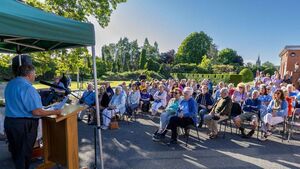New Laois memorial unveiled at tragic gravesite

Historian Michael Creagh speaking at the unveiling of a memorial for famine victims and other destitute children and adults buried in Abbeyleix. Photo: Alf Harvey
A NEW memorial was unveiled at a poignant ceremony in Laois, in honour of famine victims buried in a mass grave near a former workhouse.
The beautiful memorial headstone and limestone seat were installed in time for the prayer service on Sunday 18 May in the grounds of Abbeyleix Community Nursing Unit (CNU), formerly the district hospital where the workhouse was located.
Parish priest Fr Paddy Byrne and Canon Patrick Harvey officiated at the evening service in memory of famine victims and other destitute children and adults, who died in the Abbeyleix workhouse and were subsequently interred in a burial plot at the rear of the CNU.
The sad yet uplifting event coincided with Irish Famine Commemoration Day, which is held annually nationwide on the third Sunday in May.
The Tonduff Cillín Committee, which organised the Abbeyleix project, received permission from the HSE to create a memorial site beneath a beautiful native oak tree, which is protected by a lifelong preservation order.
The peaceful memorial includes a paved area with a limestone reflection seat, together with a headstone for a six-year-old boy who was interred in the burial plot almost 140 years ago.
The memorial stone is inscribed in both Irish and English with the words: ‘Erected in memory of all those who are buried here in this Abbeyleix Workhouse burial ground, between 1842 and 1962, in recognition that the people who are interred here are all part of God’s family’.
At the prayer service, Portlaoise writer and poet Denise Curtin recited one of the evocative poems she wrote about the resting place.
The Abbeyleix and Ballyroan choir performed at the service while Michael Creagh, who recently retired from his role at Donaghmore Workhouse, shared his extensive knowledge and insights on the devastating famine period.
The Tonduff Cillín Committee thanked the HSE management team, which not only provided the location but also organised a construction team to lay beautiful patio slabs with brick surround, while ensuring that the site is wheelchair accessible.
Noel said: “The person in charge of Abbeyleix CNU, Deirdre Phelan, was also very helpful to us throughout this period of organising, planning and agreeing the final site location, as well as collectively with management settling on the final wording that appears on the memorial stone. Local man Michael Martin translated the English text into Irish, for which we were grateful.”
The committee also liaised with Laois Heritage Officer Thomas Carolan and an archaeologist, who supervised the digging of a foundation for the memorial stone and seat.
The memorial followed a generous response to a fundraiser set up by the committee on 15 March, with a target of €500. Nearly €650 was donated within days. Originally, the committee planned to use the excess to plant wildflower seeds and maintain the burial ground into the future.
However, Bosco Whelan of Jet Stone Ltd in Ballyroan kindly refused to accept payment for producing the memorial stone and seat, as he told the committee that it was an honour to be able to help with the project.
Noel said: “As a result of Bosco’s generosity, we can now donate the money to the Friends of Abbeyleix Hospital, who will look after the site long into the future.”
The memorial headstone bears the name of John Fitzgerald (6), who died from hunger at the workhouse in May 1886 and who will now symbolise and honour all those buried at the site, most of whose names are unknown. The site continued to be used as an unofficial burial ground for decades afterwards.
John’s body was disposed of in the graveyard pit or ‘shank yard’ at the rear of the present day Abbeyleix CNU, where up to 2,000 babies, children and adults are believed to be have been buried between 1842 and 1962.
Noel said: “Unfortunately, 183 years passed without any official recognition of the site ever having been used as a burial ground for the poor and destitute people who died in the Abbeyleix workhouse. Thankfully, that has all changed this year.”





